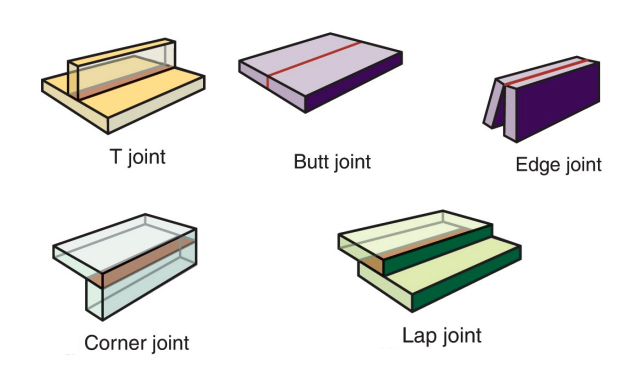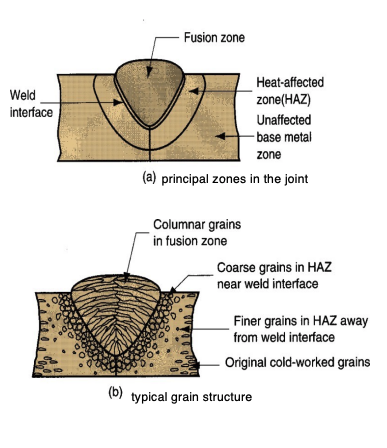Fusion Welding
1/27
There's no tags or description
Looks like no tags are added yet.
Name | Mastery | Learn | Test | Matching | Spaced |
|---|
No study sessions yet.
28 Terms
What is welding?
A joining process where two or more parts are coalesced at their faying surfaces by heat and/or pressure, often using filler material.
What is a weldment?
An assembly of parts joined by welding.
What is a faying surface?
The surface in contact at a joint to be welded.
What are key advantages of welding?
Permanent joint
can be stronger than base materials
economical
can join similar or dissimilar metals
usable in the field
What are major limitations of welding?
Labour intensive
potential defects/difficult inspection
dangerous
non-disassemblable
What is a weld joint?
The junction of edges or surfaces joined by welding.
What are the main types of weld joints?
Butt
corner
lap
tee
edge

What are the main types of welds?
Fillet weld [weld is beside workpieces]
groove (butt) weld [weld is between workpieces]
plug weld
slot weld
spot weld
seam weld.
![<p>Fillet weld [weld is beside workpieces]</p><p>groove (butt) weld [weld is between workpieces]</p><p>plug weld</p><p>slot weld</p><p>spot weld</p><p>seam weld.</p>](https://knowt-user-attachments.s3.amazonaws.com/c305d42e-dfbe-4faf-ae25-2ec2ca890264.png)
What distinguishes a fillet weld from a groove weld?
Fillet weld is beside the workpieces; groove weld is between them.
What is fusion welding?
A process using heat to melt base and filler metals to create a joint.
What is power density in welding?
Power input per unit area, defined as PD = P / A (watts per mm²).
Why is power density important in welding?
It influences whether the metal melts or vaporises and affects welding speed and quality.
What happens if power density is too low?
Heat is conducted away without melting the metal.
What happens if power density is too high?
Metal vaporises in the affected region.
What are the zones in a fusion welded joint?
Fusion zone, weld interface (fusion line), heat affected zone (HAZ), and unaffected base metal zone (UBMZ).

What is the heat affected zone (HAZ)?
A region below melting that undergoes microstructural change, often reducing mechanical properties.
Where do welding failures often occur?
In the heat affected zone (HAZ).
What are residual stresses in welding?
Stresses remaining in a weldment after external loads are removed, caused by non-uniform heating and cooling.
What problems can residual stress cause?
Distortion, warping, cracking, and the need for costly treatments or fixtures.
How can distortion be minimised in welding?
Use welding fixtures
heat sinks
tack welding
control welding parameters
preheat
post-weld heat treatment.
How are fusion welding processes classified?
By energy source:
electrical (arc, resistance)
chemical
radiation (laser, electron beam).
What are the three fusion welding modes by filler use?
Autogenous (no filler)
homogeneous (same composition)
heterogeneous (different filler composition).
What is arc welding (AW)?
A process using an electric arc to melt the base metal and electrode, forming a joint.
What are consumable electrodes?
Electrodes that melt during welding and act as filler metal.
What are non-consumable electrodes?
Electrodes (like tungsten) that don’t melt but erode slightly during welding.
What is flux in welding?
A substance that protects the weld area from contamination, promotes wetting, and forms a slag.
Why is weld protection necessary?
To prevent oxidation and hydrogen/nitrogen contamination, which can weaken the weld.
What are three flux delivery techniques?
Granular flux onto welding operation
flux-coated stick electrodes that melt during welding
flux-filled tubular electrodes.